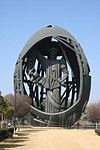Estadio de La Cartuja
1999 establishments in SpainAthletics (track and field) venues in SpainBuildings and structures in SevilleFootball venues in AndalusiaMulti-purpose stadiums in Spain ... and 4 more
Rugby union stadiums in SpainSports venues completed in 1999Sports venues in AndalusiaUEFA Euro 2020 stadiums

Estadio La Cartuja (Spanish pronunciation: [esˈta.ðjo la kaɾˈtu.xa]), officially known as Estadio La Cartuja de Sevilla, is a multi-purpose stadium situated in the Isla de la Cartuja in Seville, Spain. It is used mostly for football and it is commonly referred to as simply 'la Cartuja'. It was completed in 1999 for the World Championships in Athletics. With a capacity of 57,619 seats, La Cartuja is the 6th-largest stadium in Spain and the 2nd-largest in Andalusia. It was the venue for the 2003 UEFA Cup Final between Celtic and Porto.
Excerpt from the Wikipedia article Estadio de La Cartuja (License: CC BY-SA 3.0, Authors, Images).Estadio de La Cartuja
Ronda Norte de Sevilla, Seville Triana
Geographical coordinates (GPS) Address External links Nearby Places Show on map
Geographical coordinates (GPS)
| Latitude | Longitude |
|---|---|
| N 37.417236111111 ° | E -6.0045638888889 ° |
Address
Estadio La Cartuja de Sevilla
Ronda Norte de Sevilla
41092 Seville, Triana
Andalusia, Spain
Open on Google Maps











